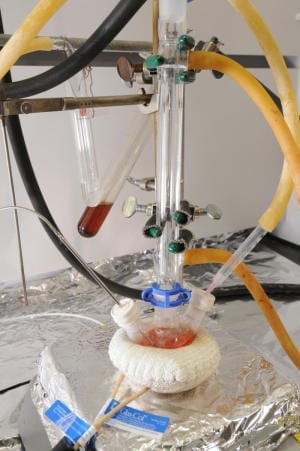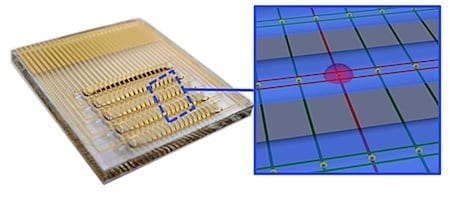
The technique could facilitate the use of nanoparticles for optical, electrical, optoelectronic, magnetic, catalysis and other applications
Using star-shaped block co-polymer structures as tiny reaction vessels, researchers have developed an improved technique for producing nanocrystals with consistent sizes, compositions and architectures – including metallic, ferroelectric, magnetic, semiconductor and luminescent nanocrystals.
The technique relies on the length of polymer molecules and the ratio of two solvents to control the size and uniformity of colloidal nanocrystals.
The technique could facilitate the use of nanoparticles for optical, electrical, optoelectronic, magnetic, catalysis and other applications in which tight control over size and structure is essential to obtaining desirable properties. The technique produces plain, core-shell and hollow nanoparticles that can be made soluble either in water or in organic solvents.
“We have developed a general strategy for making a large variety of nanoparticles in different size ranges, compositions and architectures,” said Zhiqun Lin, an associate professor in the School of Materials Science and Engineering at the Georgia Institute of Technology. “This very robust technique allows us to craft a wide range of nanoparticles that cannot be easily produced with any other approaches.”
The technique was described in the June issue of the journal Nature Nanotechnology. The research was supported by the Air Force Office of Scientific Research.
The star-shaped block co-polymer structures consist of a central beta-cyclodextrin core to which multiple “arms” – as many as 21 linear block co-polymers – are covalently bonded. The star-shaped block co-polymers form the unimolecular micelles that serve as a reaction vessel and template for the formation of the nanocrystals.
The inner blocks of unimolecular micelles are poly(acrylic) acid (PAA), which is hydrophilic, which allows metal ions to enter them. Once inside the tiny reaction vessels made of PAA, the ions react with the PAA to form nanocrystals, which range in size from a few nanometers up to a few tens of nanometers. The size of the nanoparticles is determined by the length of the PAA chain.
The block co-polymer structures can be made with hydrophilic inner blocks and hydrophobic outer blocks – amphiphilic block co-polymers, with which the resulting nanoparticles can be dissolved in organic solvents. However, if both inner and outer blocks are hydrophilic – all hydrophilic block co-polymers – the resulting nanoparticles will be water-soluble, making them suitable for biomedical applications.
Lin and collaborators Xinchang Pang, Lei Zhao, Wei Han and Xukai Xin found that they could control the uniformity of the nanoparticles by varying the volume ratio of two solvents – dimethlformamide and benzyl alcohol – in which the nanoparticles are formed. For ferroelectric lead titanate (PbTiO3) nanoparticles, for instance, a 9-to-1 solvent ratio produces the most uniform nanoparticles.
The researchers have also made iron oxide, zinc oxide, titanium oxide, cuprous oxide, cadmium selenide, barium titanate, gold, platinum and silver nanocrystals. The technique could be applicable to nearly all transition or main-group metal ions and organometallic ions, Lin said.
“The crystallinity of the nanoparticles we are able to create is the key to a lot of applications,” he added. “We need to make them with good crystalline structures so they will exhibit good physical properties.”
The Latest Bing News on:
Nanocrystals
- Development of ultra-high-efficiency pure red light-emitting devices with enhanced color representationon May 8, 2024 at 6:38 am
DGIST Professor Jiwoong Yang's team in the Energy Science and Engineering Department has successfully manufactured high-performance, skin-attachable perovskite pure red light-emitting devices to ...
- Clene Reports First Quarter 2024 Financial Results and Recent Operating Highlightson May 8, 2024 at 5:17 am
Clene Inc. (Nasdaq: CLNN) (along with its subsidiaries, “Clene”) and its wholly owned subsidiary Clene Nanomedicine, Inc., a late clinical-stage biopharmaceutical company focused on revolutionizing ...
- Bell Labs honors former researcher for 2023 Nobel Prizeon May 1, 2024 at 10:37 pm
The 80-year-old was recognized for discoveries he made while a researcher at Bell Labs in Murray Hill in the 1980s.
- Multiple sclerosis patients find hope in ‘liquid gold’on May 1, 2024 at 12:34 pm
The world has over 1.8 million people with multiple sclerosis in the world, according to the World Health Organization in 2023. The Mayo Clinic says it attacks a person’s nervous system, causing ...
- Drinking Tiny Gold Crystals May Help With MS Vision Problemson April 30, 2024 at 12:55 pm
People with multiple sclerosis who drank a medicine containing gold nanocrystals daily for nearly 3 years got better vision, according to study results presented at a neurology conference this month.
- Trials to watch: Four ALS drugs to keep an eye onon April 30, 2024 at 12:09 pm
There are a total of 12 candidates in mid to late-stage trials for ALS poised to enter the market in the next five years.
- ‘Liquid gold’ could bring new hope to multiple sclerosis patients, study suggests: ‘Profound benefit’on April 30, 2024 at 2:30 am
An experimental medication called CNM-Au8 — a drinkable liquid with gold nanocrystals — has shown promising results in clinical trials for improving MS symptoms. Doctors and researchers weighed in.
- Researchers create nanostructures for efficient and sustainable degradation of pollutantson April 23, 2024 at 5:00 pm
nanoparticle-decorated BiFeO 3 nanocrystals. Their study was published online in the journal ACS Applied Nano Materials on April 5. Experiments revealed that the sample with 1.0% Au by weight ...
- Previous theory on how electrons move within protein nanocrystals might not apply in every caseon April 23, 2024 at 11:45 am
Researchers believe that understanding how electrons move within small, natural systems could power a more sustainable future for our energy grid.
- Novel Drug Made of Gold Nanocrystals Appears Safe in Multiple Sclerosison April 22, 2024 at 10:22 am
DENVER -- An oral suspension of clean-surfaced gold nanocrystals known as CNM-Au8 was safe and well-tolerated in patients with stable relapsing-remitting multiple sclerosis (MS) and chronic optic ...
The Latest Google Headlines on:
Nanocrystals
[google_news title=”” keyword=”nanocrystals” num_posts=”10″ blurb_length=”0″ show_thumb=”left”]
The Latest Bing News on:
Nanoparticles
- Researchers develop nanotechnology for creating wafer-scale nanoparticle monolayers in secondson May 7, 2024 at 1:17 pm
Nanoscale materials present us with astonishing chemical and physical properties that help materialize applications such as single molecular sensing and minimally invasive photothermal therapy—which ...
- Dark-field X-ray imaging reveals potential of nanoparticle-delivered gene therapyon May 7, 2024 at 1:30 am
The use of magnetically guided nanoparticles as targeted delivery vehicles could one day lead to a treatment for cystic fibrosis ...
- Vietnam Silver Nanoparticles Market Navigating Growth Frontiers Market Size Explorer’s Insightson May 6, 2024 at 10:13 pm
This country research report on Vietnam Silver Nanoparticles Market offers comprehensive insights into the market landscape, customer intelligence, and competitive strategies in the Vietnam market.
- GIST researchers develop nanotechnology for creating wafer-scale nanoparticle monolayers in secondson May 6, 2024 at 4:59 pm
Scientists demonstrated a proton-assisted electrostatic assembly technique that transports nanoparticles from water within seconds while enabling 2D mono-layered assembly with excellent surface ...
- Nanotubes, nanoparticles and antibodies detect tiny amounts of fentanylon May 2, 2024 at 1:22 pm
A research team at the University of Pittsburgh led by Alexander Star, a chemistry professor in the Kenneth P. Dietrich School of Arts and Sciences, has developed a fentanyl sensor that is six orders ...
- Activity in a Room Stirs Up Nanoparticles Left by Consumer Sprayson May 2, 2024 at 1:18 am
Common household products containing nanoparticles could be contributing to a new form of indoor air pollution, as activity in a room stirs up the nanoparticles and projects them into the breathing ...
- Household sprays release dangerous nanoparticles that linger in the homeon May 1, 2024 at 10:30 am
Walking through a recently sprayed area can resuspend nanoparticles in the household up to adult breathing levels.
- Activity in a Room Stirs up Nanoparticles Left Over From Consumer Sprayson April 30, 2024 at 10:13 am
Common household products containing nanoparticles – grains of engineered material so miniscule they are invisible to the eye – could be contributing to a new form of indoor air pollution, according ...
- Penn bioengineering professor develops lipid nanoparticles to deliver mRNA inside human cellson April 29, 2024 at 12:47 am
Mitchell leads a biomaterials and drug delivery lab at Penn Engineering that works on engineering new biomaterials, such as lipid nanoparticles.
- Breakthrough rice bran nanoparticles show promise as affordable and targeted anticancer agenton April 23, 2024 at 10:45 am
Plant-derived nanoparticles have demonstrated significant anticancer effects. Researchers recently developed rice bran-derived nanoparticles (rbNPs) that efficiently suppressed cell proliferation and ...
The Latest Google Headlines on:
Nanoparticles
[google_news title=”” keyword=”nanoparticles” num_posts=”10″ blurb_length=”0″ show_thumb=”left”]










